What is Equality
The Equality and Human Rights Commission describes equality as:
‘Ensuring that every individual has an equal opportunity to make the most of their lives and talents.
It is also the belief that no one should have poorer life chances because of the way they were born, where they come from, or whether they have a disability.’
The Equalities Act 2010
The Act legally protects people from discrimination in the workplace and in wider society, including schools. As well as protecting individuals from unfair treatment, this law also promotes a fair and more equal society. Specifically, Section 1492 of the Equality Act 2010 Act places a general duty on public authorities to have due regard to: eliminating discrimination, harassment and victimisation; advancing equality of opportunity; and fostering good relations between persons who share a protected characteristic and those who do not.
The Fairer Scotland Duty and The Promise place a legal responsibility on particular public bodies in Scotland to actively consider how they can reduce inequalities of outcome caused by socio-economic disadvantage. Socio-economic Disadvantage has therefore been included with the other nine legally protected characteristics.
(adapted from Equalities and Equity Toolkit, Connect.Scot for Education Scotland, 2021)
The Protected Characteristics
(Hover over each logo to see a definition.)

Age
A particular age group (for example, 18 year olds) or range of ages (for example 18 to 30 year olds).
Disability
A physical or mental impairment which has a substantial and long-term adverse effect on that person's ability to carry out normal day-today activities.
A note on neurodivergence: While some presentations of neurodivergence are a disability, others are not. However when reflecting on inclusivity, neurodivergence is a characteristic we should be ensuring is represented and considered.
Gender Reassignment
Proposing to reassign gender, is undergoing a process to reassign gender, or has completed this process.
Marriage and Civil Partnership
Legally married or in a civil partnership. Marriage can either be between a man and a woman, or between partners of the same sex. Civil partnership is currently between partners of the same sex (NB the law is to be changed to extend civil partnership to a woman and a man).
Pregnancy and Maternity
In a non-work situation, protection against maternity discrimination is for 26 weeks after giving birth, and this includes treating a woman unfavourably because she is breastfeeding.
Race
Race, colour, nationality (including citizenship) ethnic or national origins.
Religion or Belief
Religion, including a lack of religion. Belief refers to any religious or philosophical belief and includes a lack of belief.
Sex
Being a man or a woman.
Sexual Orientation
Heterosexual, gay, lesbian or bisexual, or perceived to have a particular sexual orientation, or connected to someone who has a particular sexual orientation.
Socio-economic Disadvantage
Areas to be considered include:
Adapted from: Equalities and Equity Toolkit, Connect.Scot for Scottish Government, 2021.


